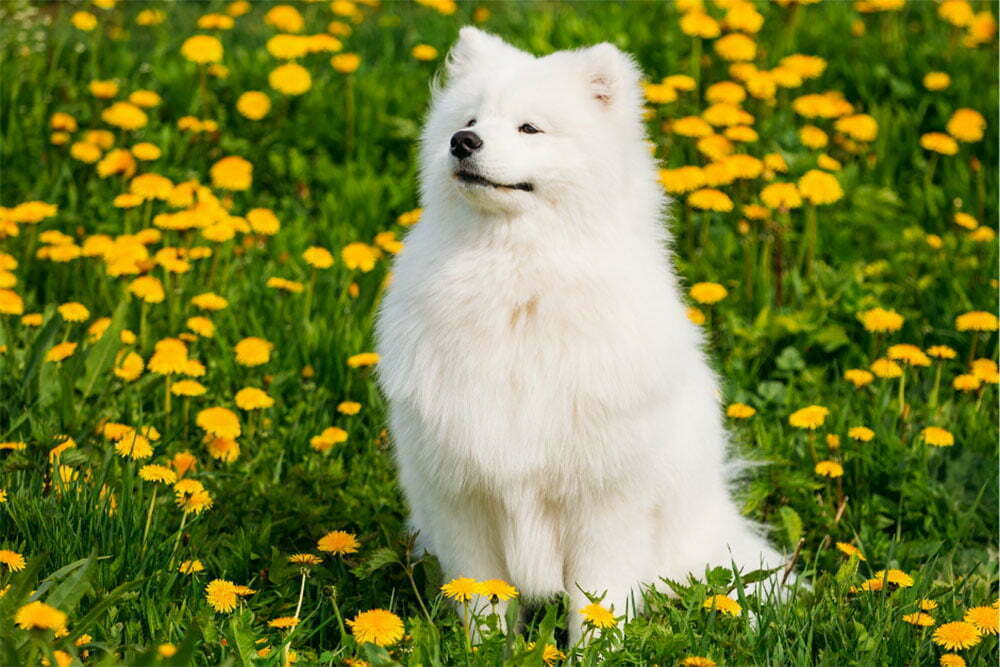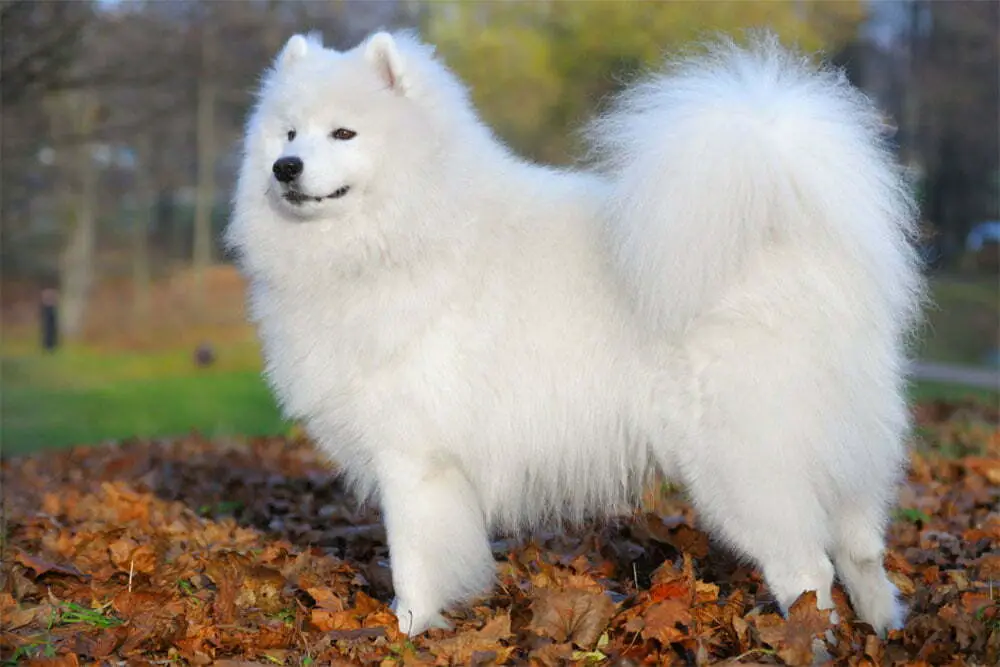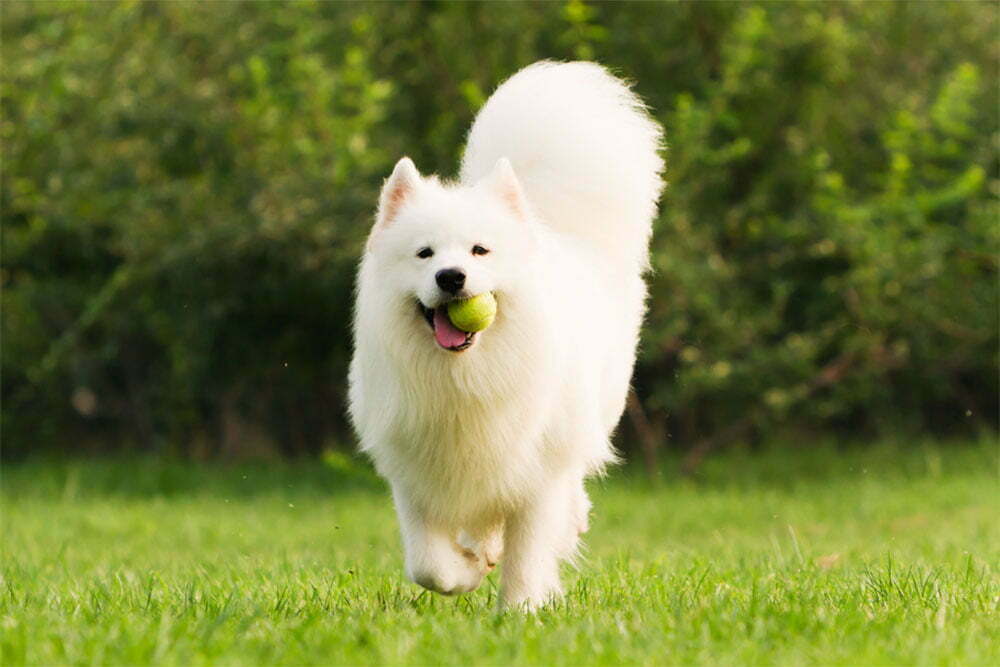If you’re thinking about introducing a dog to your family, choose an appropriate breed for you and your lifestyle. Since no two dog breeds are exactly the same, choosing the ideal dog can be a time-consuming and stressful process. Well, this is where we come in.
What about the Samoyed? This breed is probably best known for its fluffy white coat. They’re often referred to as “sammies,” These lovely dogs are cold-resistant and are a true northern breed.

They have a permanent smile, earning them the nickname “Smiley.” They are mostly used as companion dogs nowadays, but they are not ideal for everyone. Continue reading to find out if these little, fluffy canines are right for you.
This guide will teach you everything you need to know about the Samoyed breed, including how they should be trained, what they can do, their habits, vulnerabilities, and associated illnesses.
While Samoyed dogs can make wonderful family pets, it is important to know that, like any breed, they have a few qualities that can make them less-than-ideal dogs in certain situations.
Bringing a new pet into your family is never a decision to be made carelessly. Being a good pet owner is a huge responsibility, and you must ensure that you have the financial capability to commit to them for the rest of their life.
So, before you make a purchase, let’s have a look at the Ultimate Guide to the Samoyed breed!
What is a Samoyed?
Samoyeds were developed in Siberia, where arctic temperatures of -60 degrees Celsius (-94 F) are not uncommon. As a result, they develop a thick, impenetrable coat.
The term “Samoyeds” refers to the Samoyede people of Siberia, who are semi-nomadic. This breed is said to have originated among this particular group of people.
These canines, like Huskies, were employed for sledding. They towed sleds, people, and equipment across immense ice fields. They were also used as security guards and hunters.
The reindeer provided food and warmth to the Samoyede people. These dogs were occasionally used as herders; however, this was clearly their secondary role.
In the late 18th century, explorers brought the Samoyed back to England. They gained popularity after Queen Alexandra fell in love with them. In 1906, the American Kennel Club acknowledged these dogs as the first canines.
Samoyeds were kept by several explorers in America and Europe to draw sleds and deliver supplies. Scott, Shackleton, and Amundsen were among the most well-known sledders who used the Samoyed breed to help them.
While these dogs have the appearance of both Huskies and wolves, they do not have the genetics of either. They are a distinct breed but provide similar functions to a Husky.
Physical characteristics of the Samoyed dog breed
The AKC recognizes the Samoyed and has a breed standard. These canines have a very square build and are quite strong. Despite their small stature, they can more than hold their own.
Their fluffy plumed tails wrap over their backs and occasionally drape to one side. Their tail looks a lot like that of a Husky.
Their legs are medium in length, and their chests are somewhat deep. Their forequarters are straight and parallel. Their thighs are quite strong and clearly designed for endurance. Their ears are erect and thick.
They are, however, not extremely sharp and have rounded tips. They are neither small nor “bear-eared.”
The ears are rather far apart; however, they are within the outside border of the head. In other words, they should not protrude from the sides.
The ears are well-protected by the hair, which shields them from the environment. They are famous for their “sammie smile.” Their lips twist up in a perpetual smile.
Their faces are likewise deeply pigmented, especially their eyes, nose, and lips. Their black facial characteristics contrast sharply with their white coats. Blue eyes are not found in Samoyeds.
Instead, they are usually black or darkly colored. Their eyes are almond-shaped. They have extremely muscular necks. In fact, their strong size and thick coat can almost look like they don’t have a neck.
Samoyeds are typically classified as medium- to large-sized dogs. Males can weigh between 45 and 65 pounds (20.4 and 29.5 kg), while females can weigh between 35 and 50 pounds (15.8 kg to 22.68 kg).
Males can stand as tall as 21-23.5 inches (53.34 cm – 59.69 cm), but females rarely stand taller than 19-21 inches (48.26 cm – 53.34 cm).
While males are larger in general, females are far longer. Some breeders promote “mini Samoyeds.”
There is, however, no official miniature replica of this canine. Any mini-version is just the offspring of two smaller dogs or a cross between a Samoyed and a smaller dog. In other words, it’s just a marketing gimmick.
Personality Traits of the Samoyed Dog Breed
The Samoyed is a charming and sociable breed. Because they were bred to be around other dogs and people, they usually get along well with other pets. They are strongly attached to their human beings and may have separation anxiety.
These canines, as herding dogs, occasionally attempt to herd other animals. However, their instincts are not as strong as those of other herding breeds.

As a result, they do not herd as frequently as other dogs. Nonetheless, they have an eagerness to nip or chase. They are usually quite sociable with children and have ample patience for most of them.
Excited youngsters, on the other hand, can be stressed. They normally don’t like having their fur or ears pulled.
They are also smaller; thus, they can be harmed by smaller kids. This can make children scared, which is bad for everyone concerned. These dogs are not at all lethargic, but they are not as energetic as some other breeds.
They are somewhat active and lively, making them ideal for active households. Their levels of energy might be pretty high. While these canines are not exceptionally speedy, they have a high level of endurance. After all, they are working dogs.
Health Traits of the Samoyed Dog Breed
Samoyed dogs, like all canines, are prone to various health disorders, some of which can affect them from an early age. We’ll go over all of the health issues that these dogs are prone to.
Eye Issues
Glaucoma and progressive retinal atrophy are two eye disorders that can affect the Samoyed breed. Glaucoma develops when the eye’s fluid does not drain properly. This results in pressure issues, which can harm the retina and optic nerve. The most evident symptom of this condition is eye pain.
Your dog may lick his eye or become very protective of that area. Watery stools, loss of appetite, and lethargy are also typical. There may be considerable inflammation and bulging of the eyeball in extreme cases.
Blindness can strike suddenly. Both acute and chronic glaucoma can occur. Acute glaucoma develops swiftly, whereas chronic glaucoma develops much more slowly.
Progressive retinal atrophy, or PRA, is a hereditary condition characterized by the deterioration of photoreceptor cells in the eye. This eventually leads to blindness.
There are two types: early-onset and late-onset. This is a hereditary condition. A puppy must inherit it from one of its parents to receive it. The simplest method to avoid it is not to breed dogs with this eye condition.
Joint Problems
Many dogs, including the Samoyed, are prone to joint disorders. They are prone to hip dysplasia as well as patellar luxation. Both of these have varying degrees of severity and impact the joints.
Hip dysplasia is a hip socket abnormality. Because the ball and the socket do not develop at the same rate, they ultimately do not fit together. This can result in some lameness.
Some dogs have moderate hip dysplasia, while others have severe hip dysplasia. This is another inherited disease. Hip dysplasia can be passed on to puppies from dogs having the condition.
Always be certain that any breeder from whom you are considering adopting performs the necessary health tests on all of their breeding dogs.
There is no cure for this ailment; however, it can be managed with medicine. It worsens with age as the bones continue to deteriorate. Another common joint issue is patellar luxation. The kneecap is dislocated in this case.
Hereditary Glomerulopathy
This hereditary disorder only affects Samoyeds, as the name implies. It is a sex-linked condition that is found on the X chromosome. As a result, males are normally impacted more frequently because females have a “backup” X chromosome. Males typically have more severe symptoms as well. Proteinuria develops in both sexes around the age of four months. This is due to an overabundance of protein in their urine.
With this disease, when the dog is between 8 and 15 months old, he will develop kidney failure. Because there is no cure for this condition, death is unavoidable. Females typically die later since the disease proceeds more slowly. Makes are typically more severely impacted. Medication can delay the growth of the disease, but it cannot totally stop it.
How to take care of a Samoyed dog
Exercise
Samoyed dogs were designed to pull sleds and stay on their feet all day. They have a high level of endurance; thus, regular exercise is essential. This implies they require a lot of exercise.
You should take long walks every day. A single, longer walk can accomplish this. You might also take them on two shorter walks. Playtime and training are both excellent ways to get some exercise.

You can teach your dog canine sports such as agility, which will exhaust both his or her body and intellect. Because these canines are highly intelligent, they also require a great deal of cognitive stimulation.
The training addresses both of these needs at the same time. These dogs do not require a lot of space if they are well-exercised. They are ideal for apartment living if they are taken on daily walks.
Training
When it comes to training your Samoyed, keep in mind that he is a very intelligent dog. He will take pleasure in learning and gratifying you. However, given his tendency to be stubborn and naughty, it may require some patience and persistence.
Because this is such a big breed, early socialization and obedience training from puppyhood will be critical in ensuring this breed learns to walk gently on a leash.
Early socialization will also help guarantee that the beautiful and charming Samoyed is versatile and well-rounded in various settings and situations.
Grooming
The Samoyed has a dense double coat, with a rough outer coat and a soft, thick, woolly undercoat.
Samoyeds shed a lot all the time, but especially during shedding season, which can happen once or twice a year. Brushing your dog daily will help eliminate dirt and loose hair and keep him looking his best.
A slicker brush or metal comb can be used to remove mats or tangles. Nail trimming should be done every three to four weeks or as needed.
Food and Diet
Because Samoyed pups have small stomachs, they require more frequent, smaller meals than adults.
Puppies should consume three or four meals per day until they are six months old. After six months, the puppies can begin eating two meals each day, which is the same length of time that adult Samoyeds should eat.
Samoyed puppies and adults should both be fed a high-quality, nutritionally balanced diet. Speak with your dog’s veterinarian to discover more about what will help keep them healthy, and then look for a meal that contains these ingredients.
An adult Samoyed may consume 1.5 to 2.5 cups per day. The amount of food your dog consumes will vary depending on age, activity level, health concerns, etc.
If you are unsure about your dog’s serving size, consult your veterinarian.
The average price of a Samoyed dog
Samoyeds are not cheap, but they are relatively inexpensive by purebred standards. The majority of Samoyeds cost between $600 and $1500.
Some may cost $3,000 or more, especially if they come from award-winning bloodlines. Samoyeds are often regarded as one of the more expensive dog breeds available.
If you just want a pet Samoyed, you don’t need to get one with “papers,” but if you plan on breeding or showing your new pup, you’ll probably want to get a registered puppy.
Cream Samoyeds have cream-colored hair that is uniformly colored, whereas biscuit Samoyeds have light orangish-brown hair. White and biscuit-colored Samoyeds are predominantly white with biscuit-colored accents on their ears and bodies.
Because most Samoyeds are white, those with varied colored coats may be slightly more expensive.
Different businesses, including dog breeders, use various pricing models. Some aim to keep their pricing as cheap as possible in order to sell puppies as quickly as possible, while others price their puppies at the higher end of the scale.
Even if you buy your new Samoyed puppy online, the breeder’s location will influence the price, as the cost of living differs by location.
For example, a breeder in Southern California will often pay more for accommodation, veterinary services, and supplies than a breeder in Montana. These costs are often passed on to the buyer.
Frequently Asked Questions
Are Samoyed dogs hypoallergenic?
Even though no dog is totally hypoallergenic, Samoyeds are not recommended for anyone who is allergic to dogs. Because this historic breed sheds frequently, they are not considered hypoallergenic.
On the other hand, their inner coat will blow out once or twice a year. It commonly happens during the changing of the seasons in spring and autumn.
Are Samoyed dogs good with children?
Samoyeds are extremely social animals who enjoy being in a family setting. With the proper socialization, they are usually fantastic with kids and will be quite devoted to the entire family – but they may occasionally favor one particular individual.
Because of their size and sometimes rowdy attitude, it’s best to keep an eye on them while they’re around smaller kids in case they accidentally knock them over.
To avoid trouble, always supervise kids and vulnerable individuals with your Samoyed and make sure you can recognize indicators of sadness or worry in your dog.
Are Samoyed dogs suitable for first-time owners?
The simple response here is, No. While a Samoyed can make an excellent family pet, it is not the best choice for a first dog. It has a variety of personality traits that only experienced dog owners can comprehend and control.
Having said that, the Samoyed is one of the best breeds, with a reputation for being a highly clever and playful dog.
